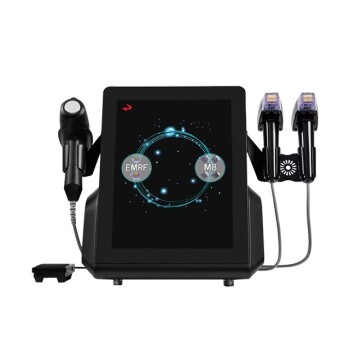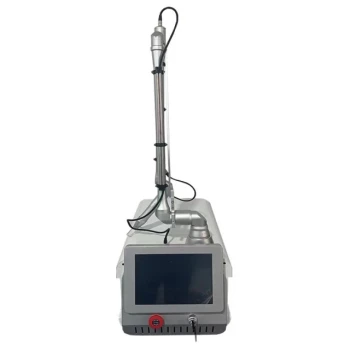In short, yes. Radiofrequency (RF) skin treatments are generally considered safe when performed by a qualified professional using an appropriate device. The most common side effects, such as redness, swelling, and mild discomfort, are temporary and a predictable part of the skin's healing response.
The safety of a radiofrequency treatment is not inherent in the technology itself, but is almost entirely dependent on the skill of the practitioner and the quality of the device. While the procedure is safe in a controlled, professional setting, the risk of adverse events like burns increases significantly with improper technique or the use of unregulated at-home devices.

How Radiofrequency Actually Works on Skin
To understand the safety profile of RF treatments, you first need to understand the mechanism. The procedure is based on a simple, controlled biological principle.
The Principle of Controlled Heating
Radiofrequency devices deliver energy into the deeper layers of your skin, primarily the dermis. This energy generates precise, low-level heat.
The goal is not to burn the skin, but to raise the temperature of the underlying tissue to a specific threshold that triggers a healing response without damaging the outer skin layer (the epidermis).
Stimulating a Natural Response
This controlled heating has a dual effect. It causes the existing collagen fibers to contract, providing an immediate, subtle tightening effect.
More importantly, it signals the body to begin its natural repair process. This process involves creating new, stronger collagen and elastin, the essential proteins that give skin its structure and firmness. The final results appear gradually over several months as this new collagen is built.
Common and Expected Side Effects
The most common side effects are direct results of the controlled heating process and are generally mild and short-lived.
Temporary Redness and Swelling
Applying heat to the dermis initiates a mild inflammatory response, which is necessary for the healing and rebuilding process. This typically presents as mild redness and swelling in the treated area, which usually subsides within a few hours to a couple of days.
Mild Discomfort
Most patients experience a sensation of deep warmth during the treatment. Professional devices often incorporate advanced cooling mechanisms to protect the outer skin layer and improve comfort, but some mild, transient discomfort is normal.
Understanding the More Significant Risks
While generally safe, RF treatments are not without risk. The most significant concerns arise from the improper application of heat.
The Risk of Burns
The most serious potential side effect is a burn. This occurs when too much energy is delivered to one area, the device is used incorrectly, or there is a machine malfunction.
A burn can lead to blistering, scarring, or changes in skin pigmentation (hyperpigmentation or hypopigmentation). This risk is the primary reason why practitioner expertise is so critical.
The Professional vs. At-Home Device Dilemma
At-home RF devices have become increasingly popular, but they carry a higher risk of user error. These devices are typically much lower in power than professional-grade machines to mitigate risk.
However, overexposure from repeated passes or using a setting that is too high for your skin can still lead to burns. The lack of a trained operator to assess skin response in real-time is the key safety compromise with at-home treatments.
Making the Right Choice for Your Goal
To minimize risk and ensure a safe experience, your approach must be guided by a clear understanding of the trade-offs.
- If your primary focus is maximum safety and efficacy: Choose a licensed and experienced professional, such as a dermatologist or certified aesthetician, who uses medical-grade equipment.
- If you are considering an at-home device for maintenance: Understand that you are assuming the role of the operator, and the risk of user error is significantly higher.
Ultimately, an informed decision based on a realistic assessment of the risks is the best way to ensure a safe and positive outcome.
Summary Table:
| Aspect | Key Takeaway |
|---|---|
| Overall Safety | Generally safe when performed by a qualified professional with appropriate equipment. |
| Common Side Effects | Temporary redness, swelling, and mild discomfort. |
| Primary Risk | Burns, which can lead to blistering or scarring, primarily from improper technique or device malfunction. |
| At-Home vs. Professional | Professional treatments offer higher safety and efficacy; at-home devices carry a higher risk of user error. |
Ready to offer safe, effective, and professional-grade radio frequency treatments?
BELIS specializes in providing advanced, reliable, and safe medical aesthetic equipment for clinics and premium beauty salons. Elevate your service offerings and ensure client safety with our professional RF machines.
Contact BELIS today to explore our solutions and enhance your practice's capabilities.
Visual Guide

Related Products
- IPL SHR+Radio frecuency machine
- Ultrasonic Cavitation Radiofrecuency Machine for Body Slimming
- Hydrofacial Machine with Facial Skin Analyzer and Skin Tester
- Cryolipolysis Fat Freezing Machine and Ultrasonic Cavitation Device
- Hydrafacial Machine Facial Clean Face and Skin Care Machine
People Also Ask
- How often do you need RF? Achieve Optimal Skin Tightening with the Right Schedule
- What does radiofrequency do to your body? Understanding Thermal Effects for Safe Treatments
- Is it safe to use RF machine everyday? Avoid These Risks for Optimal Results
- Is it safe to use an RF machine at home? How to Use Consumer Devices Safely
- What is the difference between SHR and laser hair removal? Choose the Right Method for You



















